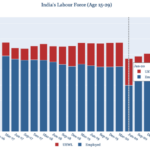Daily Food Price Index by CEDA
Summary:
-
- CEDA has created an index using daily food prices to track inflation in retail and wholesale food markets in real time
- The Daily Food Price Index by CEDA is based on data from the Department of Consumer Affairs (DoCA)
- The Food Prices Index is strongly correlated with both CPI-food as well as WPI- food at a monthly level
Introduction
India’s inflation rate based on the Wholesale Price Index reached a record high of 15.08% in April 2022 while that based on the Consumer Price Index surged to an 8-year-high of 7.79%. High inflation rates indicate that the same basket of goods and services has become more expensive over time. The volatility and trends in these rates influence monetary policies and private investment, which consequently have effects on household welfare and economic output. Accurate and timely tracking of price trends is, thus, vital for setting interest rates and executing market-based interventions to keep inflationary pressures in check.
The Government of India constructs two indices to determine the trajectory of prices in the economy — Consumer Price Index (CPI) and Wholesale Price Index (WPI). The former reports price changes in the retail market (B2C transactions), while the latter covers the wholesale market, which includes business trading in bulk. The Ministry of Statistics & Programme Implementation calculates the CPI based on a basket of goods determined by the Consumer Expenditure Survey (CES), 2011-12, i.e., the 68th round of the National Sample Survey (NSS). Each item in this basket is assigned a weight based on its share in the total expenditure. On the other hand, WPI is released by the Ministry of Commerce & Industry and uses a commodity basket as advised by concerned government ministries and departments. The item specific weights for WPI are obtained from various reports on the volume traded of a particular commodity in the wholesale market.
Both indices are currently reported on a monthly and yearly basis, with the CPI being released on the 12th day and the WPI on the 14th of every following month. The lag in publishing these can be costly since market interventions and decisions around price regulations sometimes demand more timely action. Two recent cases in point are the Covid-19 induced lockdown which led to an immediate surge in food prices, and the recent increase in prices resulting from the ongoing war between Russia and Ukraine. Public policy discourse, and policymaking in general, thus, can benefit from having a high frequency index where such data is readily available. To bridge this gap, CEDA aims to provide a daily price index for food commodities.
Share of food commodities captured by the Index
We utilize data collated by the Price Monitoring Cell (PMC) — a division under the Department of Consumer Affairs (DoCA) — on daily retail and wholesale prices of 22 commodities from 179 centres spread across India (as of May 2022).[1] The commodity list comprises of food articles that are deemed essential by the DoCA, and the centres include all major urban hubs with either substantial populations or significant trade channels. Using the State Civil Supplies Departments of various regions and a geotagged verification system, the PMC makes the price reports publicly available on the same day after cross-validation by the divisional offices of FCI and NAFED in various states and UTs. Thus, the high frequency and verified nature of the DoCA data, along with the fact that they cover both retail and wholesale markets, lends to their suitability for building an alternative index to the food sub-component of the CPI and the WPI.
Additionally, the 22 commodities tracked by the DoCA form a substantial proportion of food expenditure by urban households. To elaborate, CPI’s Food and Beverages group consists of 127 items. These items account for 45.86% of the total expenditure on goods at all India levels and 36.29% for urban India. The 22 commodities tracked by the DoCA capture 22.82% of the expenditure on total goods. Similarly, WPI’s sub-categories of Food Articles under Primary Articles and Food Products under Manufactured Products, comprising 136 items, form the WPI food Index. These capture 24.38% of the traded volume in commodities in the wholesale market. The commodities captured under the DoCA prices represent 11.88% of the traded volume. Thus, approximately half or more of the CPI and WPI indices group expenditure share is captured by the commodities whose daily prices are reported by the DoCA. An index to track food prices based on the DoCA data is then likely to serve as a good measure to track daily food price trends in the country.
Methodology for constructing the Food Price Index
DoCA has been reporting the daily commodity prices since 2009. However, the daily indices are constructed from 1stJanuary 2012 for retail prices and 1st April 2011 for wholesale prices. These dates follow directly from the latest revision of CPI and WPI, wherein the price reference year was updated to start from these months onwards. We elucidate below the two-stage approach followed to construct the CPI and WPI indices by the GoI.[2]
- Commodity (or item) Level Indices: Each commodity’s price index is computed by calculating the percentage ratio between its price in the current period and its price in the base year. A single price value for any given period is reached by taking the geometric mean (GM) of prices across every reporting market for the commodity in that period.[3]
- Aggregate Indices: Individual item indices from the first stage are then weighted by their share of expenditure (assigned weights) and arithmetically averaged over to obtain sub-group/group level price indices (Laspeyre’s Index).
The daily price index constructed by CEDA closely follows the above methodology. We first arrive at the commodity groups, base prices, and weights required to construct the index. Commodity groups are defined based on the aggregation used under the DoCA data — Grains and Pulses (further split into two separate categories), Edible Oils, Vegetables and Others. The base prices are calculated by taking the geometric mean of every commodity’s price in each centre over the respective base periods. All-India combined weights are taken for every commodity from the official manuals of CPI and WPI and reweighted so that they sum to 100 for the 22 commodities. For calculating commodity weights for group level indices, all commodities not falling within a particular group are given a weight value of zero while the official weights of the others are rescaled to 100.[4]
Thereafter, a daily price index at the commodity level is constructed by collating the current daily price information from the DoCA.[5] A geometric mean is taken over prices across all centres and denoted as the commodity’s price in the current period. This value is then divided by the predetermined base price for each commodity to obtain the relative price ratio. The ratios are multiplied by their corresponding group weights and summed up to obtain the group index value. Apart from the daily index, a monthly index for each group is also obtained by taking a geometric mean over all daily commodity-centre level prices available for a given month.[6]
Comparison of the Food Price Index with CPI and WPI Indices
We assess how the food price trends captured by the above index based on the DoCA retail and wholesale price data contrast with that of CPI-food (Urban) and WPI-food.[7] Figures 1 and 2 plot the daily and monthly food price index using the DoCA data, respectively, against the monthly CPI-food (Urban). The figures show that the two indices are strongly positively correlated. The monthly food price index based on the DoCA data reports a correlation of 0.975 with the monthly CPI-food (Urban). Thus, the price trends across the two indices are very similar. Until about 2016, the index based on the DoCA data followed the CPI very closely. Post-2016, the gap between the two continues to fluctuate within a 10% bracket. However, the rise and fall in the index values remain proportional and simultaneous and the gap between them reduces in later time periods.
For robustness, the monthly data is detrended by taking the first difference for both indicators. Figure 3 plots the detrended values for the food price index and CPI-food (Urban). It can be observed that most of the peaks and troughs in the CPI-food (Urban) Index are adequately captured by the food price index constructed by CEDA. The correlation coefficient between the detrended series is also high at 0.83.
Figure 1: Daily level retail index based on DoCA data and monthly CPI Food (Urban)

Figure 2: Monthly level retail index based on DoCA data and monthly CPI Food (Urban)

Figure 3: First difference of monthly level retail index based on DoCA data and CPI Food (Urban)

The above analyses are also conducted for wholesale prices. Figures 4 and 5 plot the WPI-food against the wholesale food price index constructed using the DoCA data at daily and monthly level, respectively. Figure 6 plots the detrended values of both indices at monthly level. The correlation between the WPI-food and the food price index based on wholesale DoCA prices is 0.98, while that between the detrended values of the indices is 0.814. These correlations are large and significant, showing that the wholesale price index based on the DoCA data can serve as a good alternative tracker for the overall WPI-food at all India levels.
Figure 4: Daily level wholesale index based on DoCA data and monthly WPI Food

Figure 5: Monthly level wholesale index based on DoCA data and monthly WPI Food

Figure 6: First difference of monthly level wholesale index based on DoCA data and WPI Food

Conclusion
The above analyses show that the price index based on the daily DoCA data provides valuable insights into the monthly price trends tracked by the CPI and WPI food indices. CEDA’s Daily Prices Data tool allows access to the food price index in two modes: daily and monthly, while allowing users to download the underlying raw data at the commodity-centre-zone level. The previous day’s retail and wholesale inflation index and the current month’s index value get updated daily. This allows for the trends in these indices to be monitored real time for tracking inflationary pressures in the country.
[1] Grains: Atta (Processed), Rice, Wheat.
Pulses: Gram Dal, Masoor Dal, Moong Dal, Tur/Arhar Dal, Urad Dal
Edible Oils: Groundnut Oil, Mustard Oil, Palm Oil, Soya Oil, Sunflower Oil, Vanaspati
Vegetables: Onion, Potato, Tomato
Others: Gur, Milk, Salt Pack (Iodised), Sugar, Tea Loose
[2] CPI Manual and WPI Manual.
[3] This calculation using the Geometric Mean (GM) is known as Jevon’s Index Formula and is preferred over taking the arithmetic mean (the previously used Carli Index Formula). The former is considered more robust since it gives equal weightage to upward and downward price movements, while the latter gives a higher weight to the upward movements.
[4] [DoCA Rescaled Weights] For certain commodities of DoCA, there are only broad food items listed in the CPI, such as “refined oils [sunflower, soyabean, saffola, etc.]”. Therefore, in the retail index, the weight attributed to the broad category is distributed equally among Sunflower Oil, Soya Oil and Palm Oil. Similarly, Atta (Wheat) (processed version) and Wheat split the weight given to CPI’s “wheat/atta” commodity.
[5] Since wholesale and retail DoCA data units differ due to the bulk purchases made in wholesale markets, they are converted to Rs. Per Kg for uniformity. We also perform data cleaning to detect outliers due to a very sudden and massive price change of greater than 1000% from the previous date, they are dropped from the data. Such cases are rare, but cleaning ensures greater precision in the index calculation.
[6] CEDA performs an automated daily scrape of DoCA’s reporting portal to maintain an up-to-date price tracker. Since new prices are appended to the current month every day, its value is recalculated and updated at the same time interval.
[7] The data for CPI-food (Urban) and WPI monthly food index are sourced from the RBI’s Database on Indian Economy.
If you wish to republish this article or use an extract or chart, please read CEDA’s republishing guidelines.








